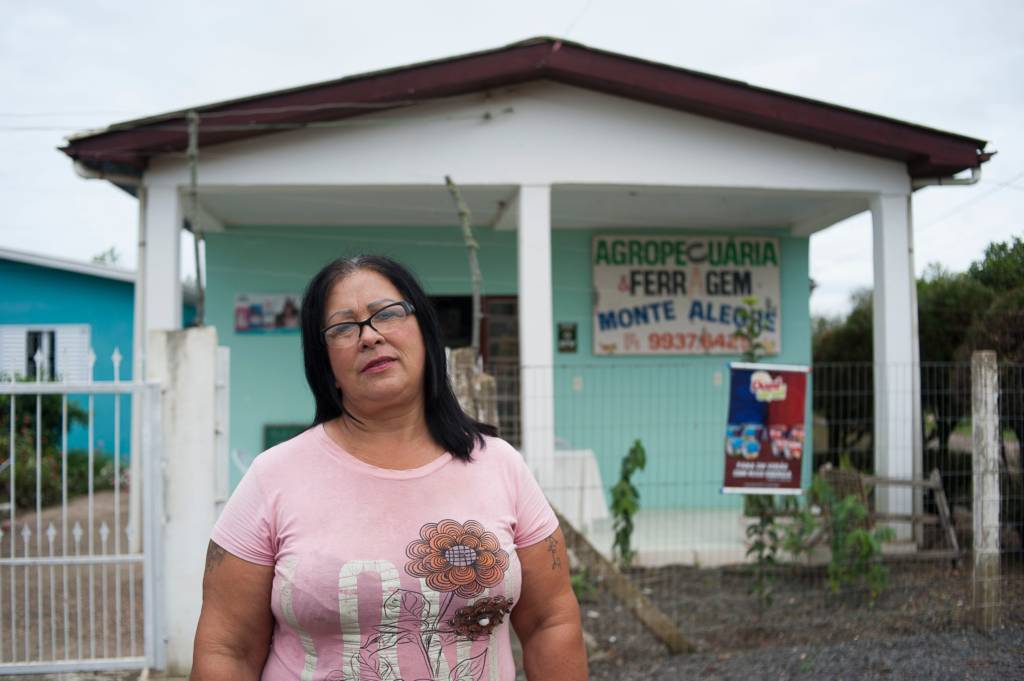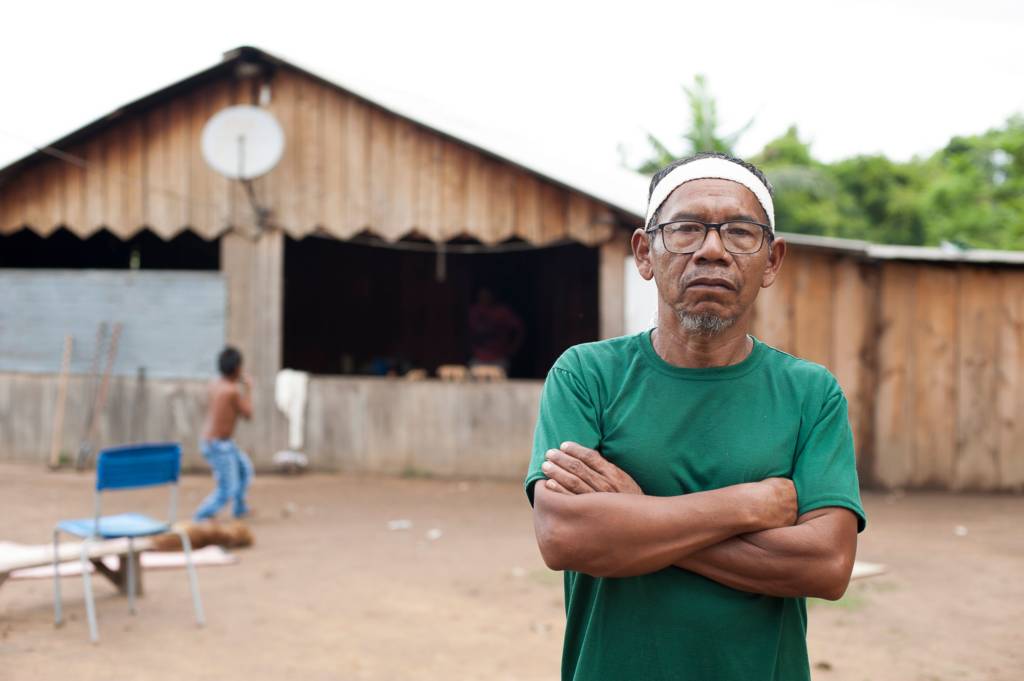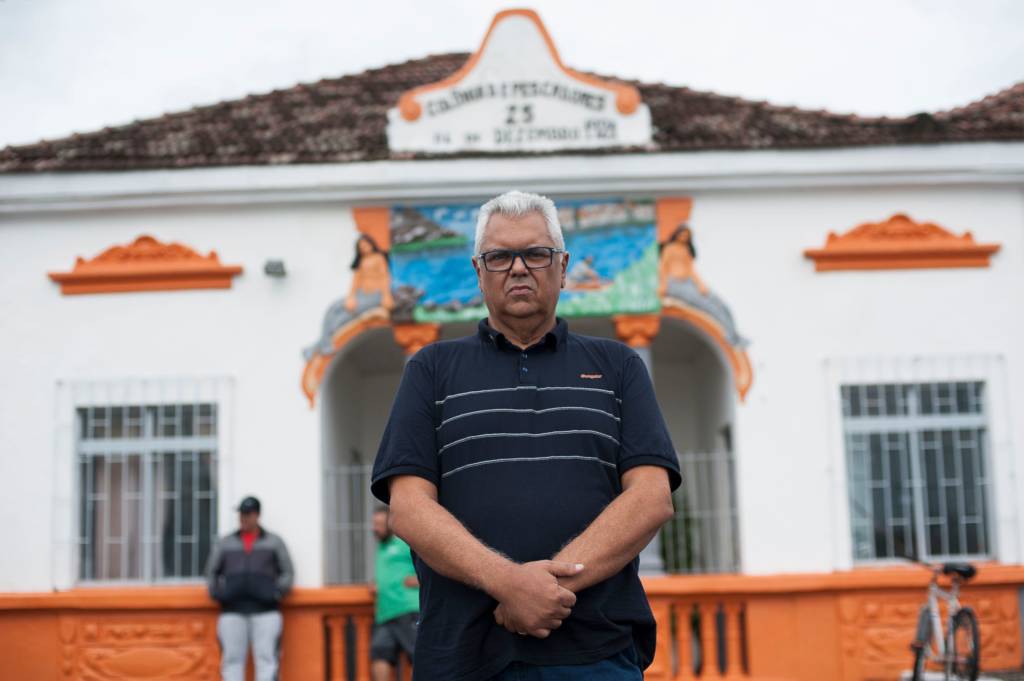“The mine was meant to be here,” says Sirlei de Souza, stamping her foot on the dirt floor in front of her house, in a countryside community in Charqueadas, in the rural Rio Grande do Sul. “It would’ve been all of this here,” she adds, extending her hands in all directions, indicating an area spanning the horizon. Beneath the immensity of a flat land covering 4,500 hectares, dotted by few houses, organic rice plantations, and some vestige of typical Atlantic Forest vegetation, there is a vast coal reserve that will not be mined.

Sirlei de Souza. Photo credit: Ramiro Furquim
The Guaíba Mine was a mega-project that the company Copelmi wanted to erect between the cities of Charqueadas and Eldorado do Sul, in the southernmost state of Brazil. The victory against the coal mine is a result of collective efforts. “The big factor of success was each community showed up; had it been just one, it would’ve been ‘only the Indigenous’ or ‘only the fishermen’,” says Gilmar da Silva Coelho, president of the Z-5 Fishermen’s Colony from Ilha da Pintada, part of the territory of the capital Porto Alegre. He adds that each community “is already a lot,” but he knows that the recognition of all communities coming together had a collective impact.
To try to open the largest open-pit coal mine in Latin America, the company bet on the developmental narrative of job creation and the increase in tax collection by both municipalities and the State. It thus won over politicians from different administrations and ideologies, but it did not have the same success in convincing communities. Recently, Copelmi suffered setbacks in court in lawsuits filed by NGOs in support of the demands of local communities that would have been affected by the opening of the mining company. After more than seven years since the first news about the Guaíba Mine emerged, the communities’ protests culminated in the shelving of the licensing process by the state environmental agency in March 2022.
Lack of information and public consultation served as a basis for questioning in the courts
“The first thing I said was: I’ll analyze it, but by default, I’m against it”, says Gilmar da Silva Coelho remembering when he first heard about the project. It was by chance since the company did not contact the community concerning the mine’s impact analysis and planning phase. He was against the proposal right away, as it was clear that the mine would impact his wider community – Ilha da Pintada is one of the points where the Jacuí River flows into Lake Guaíba. A few kilometres upstream in its course, the treated effluents from the mine would have flown into the same Jacuí River. There was a general fear that it would affect the water, just as the extraction and burning of coal would pollute the air.
Subtitles in English available under CC on the video
And overall, there was a lack of information. Copelmi held public consultations in Charqueadas and Eldorado, complying with its legal obligations only. It left out Porto Alegre and several surrounding cities. “We didn’t know anything, we weren’t heard, we didn’t have a voice,” says Gilmar, who was present at one of the consultations. The intention was to understand what was happening to share more information with other fishermen – more than 1,500 are part of the colony, and most fish in the Jacuí river – but he realized that consultation was created only “to validate” the process.
The strategy adopted was to file a lawsuit, including requesting that the community be heard in its place of origin. The same strategy was adopted by the Mbya Guarani people, as Copelmi did not carry out prior consultations with Indigenous communities that would be directly or indirectly affected by coal mining. This action yielded one of the victories against Mina Guaíba in court.

Chief Santiago. Photo credit: Ramiro Furquim
“We were never informed, I didn’t know what was happening,” confirms Chief Santiago, from the Yvy Poty Village, of the Mbyá Guarani peoples. His family’s home is in an area surrounded by forest and protected by the federal government and Funai, as indicated by the signs on the access road that cuts through the municipality of Barra do Ribeiro. Today, 63 people live in three different parts of the forest that has been home to their community since the beginning, says the leader. They plant corn and banana, raise chicken, and fish in a pond, all for their consumption. Some newly planted orange trees are as tall as the children who run around the village with their dogs.
Chief Santiago uses the wisdom of traditional peoples to affirm what science and law state: nature has no borders. “Indigenous culture has life, and the protection of life is always in the forest, in the environment, in the river. This destruction of water has been going on for a long time, attacking our way of life. Although we’re distant from cities, eventually everyone will be contaminated in the future. This is the life that the juruá (non-indigenous person) does not see, that the company does not see. It’s assumed that only those who live close to the mine will be contaminated, but that’s not how we see it. In the future, the wind will sweep up the pollution and carry it across a million kilometres, not just 20 kilometres. Because the wind has no limits.”
The wind blows in all directions in the almost open field where the mine would have been installed, says Sirlei, gesticulating in all directions. Her hair is ruffled by the south wind that blows hard on a cloudy autumn morning in the Guaiba City subdivision in Charqueadas, where she lives. Were it to the east, the wind and everything it carries would be heading towards the metropolitan region of Porto Alegre, a fact often used to raise awareness and mobilise people against coal mining.
“It wouldn’t have just impacted Guaíba City and the agrarian land reform settlement (Apolônio de Carvalho, from the Landless Workers Movement- MST). All surrounding communities would have experienced acid rain, which causes cancer and all kinds of diseases,” points out Sirlei. The approximately 20 kilometers pointed out by Chief Santiago separate the place where the mine was meant to be and the center of the state capital. Undoubtedly, many people would have suffered the consequences of the largest open-pit coal mine in Latin America. But it is the recognition of local communities’ rights that guaranteed civil society’s victory against the Guaíba Mine.
Change in opinion about the mine
Sirlei de Souza worked as a public health agent in the Guaiba City subdivision, a rural area of Charqueadas, the place she chose to call home 25 years ago. Today she raises pigs, cows and other animals, has a vegetable garden, orchards, and a small neighbourhood business. At first, she was in favour of the coal mine. Sirlei considered selling her property to Copelmi and leaving “partly due to the poor quality of municipal services.” To open the mine, residents of the Guaiba City subdivision and the MST agrarian reform Apolônio de Carvalho settlement would require resettlement and were contacted by the company.
Subtitles in English available under CC on the video
But opinions began to change when residents understood the nature of a mining company. “They were going to mine the coal with us living right here. Can you imagine the hell our lives were going to be?” she blurts out. According to information passed on to Sirlei and the rest of the community, the company’s idea was to open the mine as soon as possible without waiting for the entire complex to be ready. “In addition to breathing polluted air, I would not have slept, I would have seen houses shaking, walls cracking, floors sinking. They would have driven us out, out of sheer desperation,” she concludes.
Sirlei’s opinion also changed when she critically analysed the company’s narrative, such as the compensation to be paid for the land and the jobs they would generate. “As there is a lot of unemployment, people felt hopeful. But Copelmi has teams currently operating at other mines, who would have relocated here. The only real opportunity for job generation was construction work, which is a fast process and not long-term”, she ponders.
Cristiane Pissoni, a neighbor who went to buy corn for the chickens at Sirlei’s sale that autumn morning, shared her plans about the organic farm she is setting up nearby: “There is a lot we can do here to generate employment, there is no need for a mining company to come to exploit our soil and not give jobs to anyone (here).”
A constant state of alert
“The issue of the mine ‘exploded’ when several collective community fronts began to work together,” says Gilmar da Silva Coelho, president of the Z-5 Fishermen’s Colony, alluding to the increasing press coverage that began once protests on the mainland gained strength. The mainland is how residents of the Arquipélago neighbourhood, where Ilha da Pintada is located, refer to the rest of Porto Alegre. Protests grew, gained more supporters, and began to shame the politicians who previously “were against us and in favour of Copelmi,” points out Sirlei de Souza. “Starting with our governor, who at first was favourable. The previous governor laid the table ready for the next one to sit at. This is the truth”, she adds.

Gilmar da Silva Coelho. Photo credit: Ramiro Furquim
For over 50 years, since people started talking about the Carbochemical Pole, the Carboniferous Pole and the Guaíba Mine, the lives of those who would have been resettled “stopped in time and space,” says Sirlei. Those who wanted to renovate their house or invest in their property ended up not doing so. “We are finished (with the licensing filing). Now people can build if they want, plant if they want, do whatever they want because they know they’re not going to have to leave”, she celebrates.
Whilst the plans are back on the table, one foot is firmly on the floor, the other behind the back. “I still don’t believe 100% that they’re not planning something behind closed doors”, Sirlei utters in response to whether she is at peace. “We feel relief that the mine will not open now. But my question is: ‘What about the future? When we are no longer here and our children and grandchildren are, will the mine not open then?’”.
Gilmar da Silva Coelho apologizes for his language, which he deems necessary to emphasise the urgency: in the case of Mina Guaíba, it is necessary to kill the evil at its root. He compares it with the inço, “which you need to eliminate before it takes over your entire land.” The mega coal mining project was not eliminated, but Gilmar believes that community mobilization and legal actions “managed to contain its growth.” But you have to be vigilant.” he warns.
In Chief Santiago’s village and the other Mbya Guarani villages in the state, spirituality was a key ally in the protests against the Guaíba Mine. “Our connection to nature helped prevent this from happening,” he says, also recognizing the role of NGOs and traditional communities of juruápeople. “We will forever be on our feet, fighting for the government to respect our rights.
Subtitles in English available under CC on the video
Particular perspectives of each of these communities are bound by a greater concern, which intersects with the climate agenda at a global level. “The mine is extremely polluting and thus also contributes to global warming,” says the fisherman. “We would have taken a big step backward in terms of environmental viability. Today the whole world is abandoning coal and Rio Grande do Sul is holding back Brazil. It is a disregard for our state and country,” he criticizes.
“A positive outcome is how all communities came together to fight against a large project that is harmful to our ecosystem. At this moment (the judicial court process is) theoretically closed, but it may not be in the future. We have to watch closely not to let it happen. The objective is to try to protect our planet as much as possible so that we can survive in the coming years,” concludes Gilmar.
